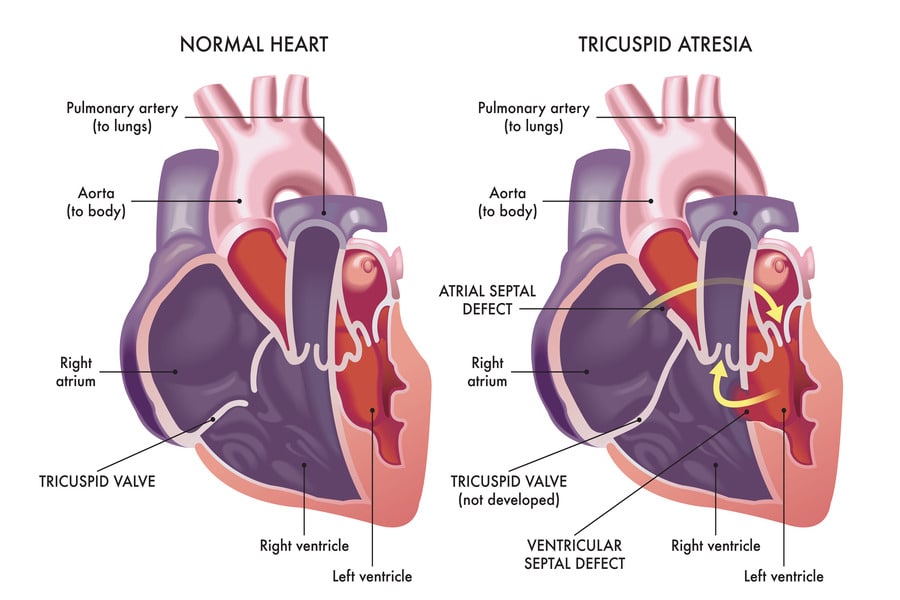Tricuspid Atresia is a complex congenital heart defect (CHD) that affects the heart’s structure and function from birth. In this condition, the tricuspid valve—a crucial valve separating the right atrium from the right ventricle—is either missing or abnormally developed. This prevents the normal flow of blood from the right atrium to the right ventricle and onward to the lungs. Tricuspid atresia requires specialized medical attention and, in many cases, surgical intervention. In this comprehensive article, we will explore the definition, overview, symptoms, causes, risk factors, treatment options, preventive measures, and when to seek medical attention for tricuspid atresia.
Defining Tricuspid Atresia
The heart’s valves play a crucial role in ensuring the unidirectional flow of blood through its chambers. Tricuspid atresia disrupts this flow by affecting the tricuspid valve. In a healthy heart, blood returning from the body enters the right atrium and then flows through the tricuspid valve to the right ventricle. From there, it’s pumped to the lungs to receive oxygen before returning to the left atrium and eventually reaching the rest of the body. However, in tricuspid atresia, the underdeveloped or missing tricuspid valve impedes blood flow, leading to serious circulation issues.
Overview of Symptoms
The symptoms of tricuspid atresia can vary depending on the severity of the condition and the presence of other heart defects. Newborns with tricuspid atresia often exhibit signs of cyanosis—a bluish discoloration of the skin and lips—due to inadequate oxygen supply. Other common symptoms include:
- Rapid Breathing: Infants may experience rapid breathing as their bodies attempt to compensate for the lack of oxygen.
- Poor Feeding: Difficulty feeding and tiring easily during feeding.
- Fatigue: Older children and adults with tricuspid atresia may experience fatigue and exercise intolerance due to inadequate oxygen supply.
- Clubbing: In some cases, the fingertips and nails may become clubbed, which is a sign of chronic low oxygen levels.
Common Causes of Tricuspid Atresia
The exact cause of tricuspid atresia is often unknown, although it is believed to occur during early fetal development. Genetic factors and maternal conditions, such as maternal diabetes or exposure to certain medications, may contribute to the risk of congenital heart defects, including tricuspid atresia. However, in many cases, tricuspid atresia occurs sporadically without a clear familial or environmental link.
Risk Factors for Tricuspid Atresia
While the specific risk factors for tricuspid atresia are not always well-defined, certain maternal conditions and factors can increase the likelihood of congenital heart defects, including tricuspid atresia:
- Maternal Diabetes: Poorly controlled diabetes during pregnancy can increase the risk of heart defects.
- Maternal Infections: Certain infections during pregnancy can impact fetal heart development.
- Maternal Medication Use: Some medications, if taken during pregnancy, may raise the risk of congenital heart defects.
Preventing Tricuspid Atresia
Because tricuspid atresia is typically a result of complex developmental processes during pregnancy, there is often no definitive way to prevent it. However, pregnant individuals can take measures to minimize the risk of congenital heart defects, including:
- Prenatal Care: Regular prenatal visits and medical supervision are essential to monitor the developing fetus.
- Healthy Lifestyle: Maintaining a healthy lifestyle, including a balanced diet and avoiding harmful substances, is crucial during pregnancy.
- Managing Chronic Conditions: If the mother has chronic conditions like diabetes, working closely with healthcare providers to manage them is essential.
When to Seek Medical Attention
If a newborn or child shows symptoms such as cyanosis, rapid breathing, or poor feeding, immediate medical attention is necessary. Early diagnosis and intervention are vital to prevent complications and improve outcomes. Pediatric cardiologists are specialized in diagnosing and treating congenital heart defects, including tricuspid atresia. They will conduct thorough evaluations, including echocardiograms and other imaging tests, to determine the best course of action.
Treatment Options for Tricuspid Atresia
The treatment for tricuspid atresia typically involves a combination of medical management and surgical interventions. Surgery may include procedures to improve blood flow and decrease oxygen deficiency. In some cases, a series of surgeries may be required over the child’s life to ensure proper circulation and oxygenation.
In conclusion, Tricuspid Atresia is a complex congenital heart defect that requires specialized medical attention and intervention. Early diagnosis, appropriate treatment, and ongoing medical care can greatly improve the long-term outcomes for individuals affected by this condition. By understanding the causes, recognizing symptoms, and seeking timely medical assistance, individuals can take proactive steps to ensure the best possible health and quality of life for those with tricuspid atresia.









